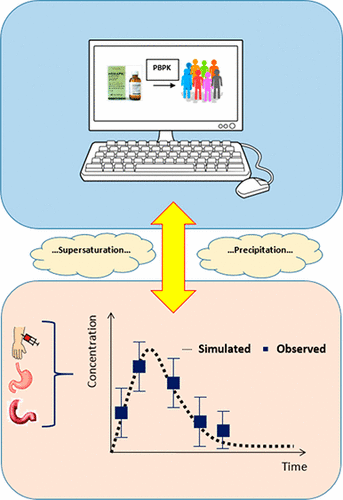当前位置:
X-MOL 学术
›
Mol. Pharmaceutics
›
论文详情
Our official English website, www.x-mol.net, welcomes your
feedback! (Note: you will need to create a separate account there.)
In Silico Modeling Approach for the Evaluation of Gastrointestinal Dissolution, Supersaturation, and Precipitation of Posaconazole
Molecular Pharmaceutics ( IF 4.5 ) Pub Date : 2017-09-05 00:00:00 , DOI: 10.1021/acs.molpharmaceut.7b00396 Bart Hens 1, 2 , Shriram M. Pathak 3 , Amitava Mitra 4, 5 , Nikunjkumar Patel 3 , Bo Liu 3 , Sanjaykumar Patel 6 , Masoud Jamei 3 , Joachim Brouwers 2 , Patrick Augustijns 2 , David B. Turner 3
Molecular Pharmaceutics ( IF 4.5 ) Pub Date : 2017-09-05 00:00:00 , DOI: 10.1021/acs.molpharmaceut.7b00396 Bart Hens 1, 2 , Shriram M. Pathak 3 , Amitava Mitra 4, 5 , Nikunjkumar Patel 3 , Bo Liu 3 , Sanjaykumar Patel 6 , Masoud Jamei 3 , Joachim Brouwers 2 , Patrick Augustijns 2 , David B. Turner 3
Affiliation

|
The aim of this study was to evaluate gastrointestinal (GI) dissolution, supersaturation, and precipitation of posaconazole, formulated as an acidified (pH 1.6) and neutral (pH 7.1) suspension. A physiologically based pharmacokinetic (PBPK) modeling and simulation tool was applied to simulate GI and systemic concentration–time profiles of posaconazole, which were directly compared with intraluminal and systemic data measured in humans. The Advanced Dissolution Absorption and Metabolism (ADAM) model of the Simcyp Simulator correctly simulated incomplete gastric dissolution and saturated duodenal concentrations of posaconazole in the duodenal fluids following administration of the neutral suspension. In contrast, gastric dissolution was approximately 2-fold higher after administration of the acidified suspension, which resulted in supersaturated concentrations of posaconazole upon transfer to the upper small intestine. The precipitation kinetics of posaconazole were described by two precipitation rate constants, extracted by semimechanistic modeling of a two-stage medium change in vitro dissolution test. The 2-fold difference in exposure in the duodenal compartment for the two formulations corresponded with a 2-fold difference in systemic exposure. This study demonstrated for the first time predictive in silico simulations of GI dissolution, supersaturation, and precipitation for a weakly basic compound in part informed by modeling of in vitro dissolution experiments and validated via clinical measurements in both GI fluids and plasma. Sensitivity analysis with the PBPK model indicated that the critical supersaturation ratio (CSR) and second precipitation rate constant (sPRC) are important parameters of the model. Due to the limitations of the two-stage medium change experiment the CSR was extracted directly from the clinical data. However, in vitro experiments with the BioGIT transfer system performed after completion of the in silico modeling provided an almost identical CSR to the clinical study value; this had no significant impact on the PBPK model predictions.
中文翻译:

Insilico建模方法评估泊沙康唑的胃肠道溶解,过饱和和沉淀
这项研究的目的是评估泊沙康唑在胃肠道(GI)的溶解,过饱和和沉淀,将其制成酸化(pH 1.6)和中性(pH 7.1)悬浮液。基于生理的药代动力学(PBPK)建模和模拟工具被用于模拟泊沙康唑的胃肠道和全身性浓度-时间曲线,这些曲线与人体中的腔内和全身数据直接进行了比较。Simcyp Simulator的高级溶出吸收和代谢(ADAM)模型可正确模拟中性混悬液给药后十二指肠液中胃不完全溶解和泊沙康唑在十二指肠中的饱和浓度。相比之下,服用酸化悬浮液后,胃部溶解度提高了约2倍,当转移至上小肠时,会导致泊沙康唑的浓度过饱和。泊沙康唑的沉淀动力学由两个沉淀速率常数描述,并通过两阶段介质变化的半力学模型提取体外溶出度测试。两种制剂在十二指肠腔室中的暴露量有2倍的差异,与全身性暴露量有2倍的差异相对应。这项研究首次证明了对弱碱性化合物的GI溶解,过饱和和沉淀的计算机模拟预测,部分是通过体外溶出实验的建模获得的,并通过GI液体和血浆中的临床测量得到了验证。PBPK模型的敏感性分析表明,临界过饱和比(CSR)和第二沉淀速率常数(sPRC)是该模型的重要参数。由于两阶段培养基更换实验的局限性,CSR直接从临床数据中提取。然而,在完成计算机模拟后,使用BioGIT转移系统进行的体外实验提供了与临床研究值几乎相同的CSR;这对PBPK模型的预测没有重大影响。
更新日期:2017-09-05
中文翻译:

Insilico建模方法评估泊沙康唑的胃肠道溶解,过饱和和沉淀
这项研究的目的是评估泊沙康唑在胃肠道(GI)的溶解,过饱和和沉淀,将其制成酸化(pH 1.6)和中性(pH 7.1)悬浮液。基于生理的药代动力学(PBPK)建模和模拟工具被用于模拟泊沙康唑的胃肠道和全身性浓度-时间曲线,这些曲线与人体中的腔内和全身数据直接进行了比较。Simcyp Simulator的高级溶出吸收和代谢(ADAM)模型可正确模拟中性混悬液给药后十二指肠液中胃不完全溶解和泊沙康唑在十二指肠中的饱和浓度。相比之下,服用酸化悬浮液后,胃部溶解度提高了约2倍,当转移至上小肠时,会导致泊沙康唑的浓度过饱和。泊沙康唑的沉淀动力学由两个沉淀速率常数描述,并通过两阶段介质变化的半力学模型提取体外溶出度测试。两种制剂在十二指肠腔室中的暴露量有2倍的差异,与全身性暴露量有2倍的差异相对应。这项研究首次证明了对弱碱性化合物的GI溶解,过饱和和沉淀的计算机模拟预测,部分是通过体外溶出实验的建模获得的,并通过GI液体和血浆中的临床测量得到了验证。PBPK模型的敏感性分析表明,临界过饱和比(CSR)和第二沉淀速率常数(sPRC)是该模型的重要参数。由于两阶段培养基更换实验的局限性,CSR直接从临床数据中提取。然而,在完成计算机模拟后,使用BioGIT转移系统进行的体外实验提供了与临床研究值几乎相同的CSR;这对PBPK模型的预测没有重大影响。











































 京公网安备 11010802027423号
京公网安备 11010802027423号